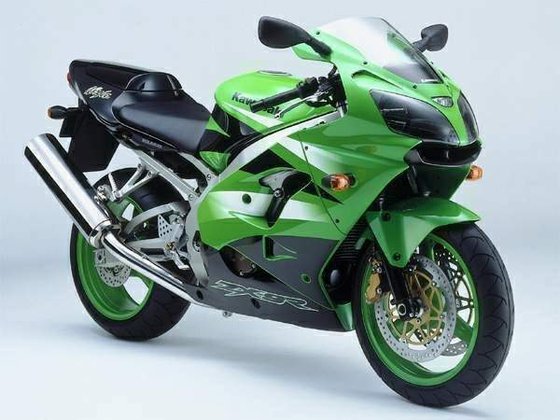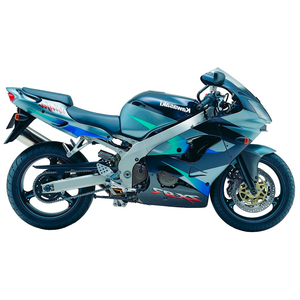Kawasaki ZX-9R Ninja [2002-2003]: A Timeless Open-Class Contender

Introduction
The early 2000s marked a fascinating era for sportbikes, where manufacturers balanced raw power with evolving chassis technology. Among these, the Kawasaki ZX-9R Ninja (2002-2003) carved its niche as a versatile open-class machine. While contemporaries like Yamaha’s R1 and Honda’s Fireblade chased lighter weights and sharper handling, Kawasaki doubled down on stability, torque-rich performance, and surprising comfort. Riding this bike today feels like stepping into a time capsule of engineering intent—a machine designed not just for lap times, but for the joy of riding itself. Let’s dissect why this generation remains a cult favorite among sport-touring enthusiasts and weekend canyon carvers alike.
Design & Aesthetics

The 2002 refresh gave the ZX-9R a sharper identity. Borrowing styling cues from its hyperbike sibling, the ZX-12R, it featured a twin-headlight front fairing with a pronounced ram-air intake below—a design that still looks purposeful today. The angular tail section and underbelly titanium exhaust (stainless steel in California models) balanced aggression with functionality, offering ample cornering clearance. Color options—Kawasaki Green, Silver, and Blue—were unapologetically bold, celebrating the brand’s racing heritage.
Build quality felt robust, with a pressed-aluminum twin-spar frame and magnesium engine covers reducing weight to 186 kg (410 lbs). The 18L (4.7-gallon) fuel tank and 827 mm (32.6-inch) seat height struck a balance between sporty intent and long-haul practicality. Unlike today’s minimalist dashboards, the ZX-9R’s analog gauges (with a digital tripmeter and clock) exuded a charmingly analog vibe.
Engine & Performance

At its heart lay a 899cc liquid-cooled inline-four, producing 144 HP @ 11,000 RPM and 101 Nm (74.5 lb-ft) @ 9,200 RPM. While carburetors (Keihin CVKD40) might seem archaic next to modern fuel injection, they delivered a visceral throttle response. The engine’s party trick was its midrange punch—roll on at 4,000 RPM in sixth gear, and it pulled with locomotive urgency.
Key innovations included:
- K-TRIC Ignition: Adjusted timing based on throttle input for smoother power delivery.
- Titanium Muffler: Reduced weight and improved mass centralization.
- Ram-Air Induction: Boosted top-end power, audible as a mechanical growl above 8,000 RPM.
Test riders noted a 0-100 km/h (0-62 mph) time of 3.1 seconds and a top speed of 281 km/h (174 mph). Yet, it was the engine’s flexibility that stood out—commuting in traffic or devouring highways felt equally effortless.
Handling & Suspension

The ZX-9R’s chassis prioritized stability over flickability. Its 1,417 mm (55.8-inch) wheelbase and braced swingarm provided confidence in high-speed sweepers, though tighter corners required deliberate countersteering. The 46mm conventional forks (preload, compression, and rebound adjustable) and Uni-Trak rear shock soaked up bumps admirably, aided by a 190/50-ZR17 rear tire for grip.
Owners often swapped the stock 190-section tire for a 180 to quicken steering. Still, the bike’s weight distribution (52% front/48% rear) ensured predictable manners, even when pushing hard. Ground clearance was generous, with only the hero knobs grazing asphalt at extreme lean angles.
Braking System

The 2002 model’s switch to Nissin 4-piston calipers (from 6-piston Tokicos) was a masterstroke. Biting on 310mm front rotors, they offered immense stopping power with sublime modulation—no wooden lever feel here. The rear 220mm disc provided adequate feedback, though it was rarely needed outside of low-speed maneuvers.
Testers praised the brakes as “the best stock setup of its era,” rivaling modern radial-mount systems. Pad longevity was decent, but aggressive riders benefited from upgraded sintered pads.
Comfort & Ergonomics

Where the ZX-9R truly shined was ergonomics. The semi-aggressive riding position (lower bars than a tourer, higher pegs than a race replica) allowed all-day comfort. Wind protection from the fairing was superb, with minimal buffeting at highway speeds. The seat, while firm, supported longer rides better than the plank-like perches of rivals.
Passenger accommodations were surprisingly generous, though the lack of grab rails (omitted post-2001) made sudden braking… intimate. Storage under the pillion seat fit a toolkit or small U-lock—a nod to practicality.
Competition
The ZX-9R faced fierce rivals:
1. Honda CBR900RR Fireblade (2002): Lighter (168 kg) and sharper, but lacked the Kawasaki’s torque and comfort.
2. Yamaha YZF-R1 (2002): More powerful (152 HP) and agile, yet twitchy at high speeds.
3. Suzuki GSX-R1000 (2002): A horsepower king (160 HP) but raw and demanding.
Kawasaki’s strength lay in its duality. It couldn’t match the R1’s track prowess but outclassed it as a road bike. The GSX-R1000 felt frenetic; the ZX-9R remained composed. For riders seeking one bike to rule twisties and tours, it was a compelling choice.
Maintenance

Owning a 20-year-old sportbike demands diligence. Key considerations:
Engine & Valves
- Valve Clearances: Check every 24,000 km (15,000 miles). Intake: 0.15–0.24 mm, Exhaust: 0.22–0.31 mm (cold).
- Oil Changes: Use 10W-40 (3.3L with filter). Frequent changes (every 5,000 km) protect the high-revving internals.
- Carburetors: Sync every 12,000 km to prevent flat spots.
Chassis & Drivetrain
- Chain: Replace the 110-link DID chain and 16/41 sprockets as a set. Lubricate every 500 km.
- Suspension: Rebuild forks every 30,000 km. Upgrade to Öhlins springs for heavier riders.
- Tire Pressures: 2.5 bar (36 psi) front / 2.9 bar (42 psi) rear for street use.
Cooling & Electrics
- Coolant: Flush every 2 years with Kawasaki Genuine Long Life.
- Spark Plugs: NGK CR9EK (gap 0.7 mm) every 12,000 km.
MOTOPARTS.store Recommendations:
- Upgrade to a slip-on Akrapovič exhaust for weight savings and a richer exhaust note.
- Install EBC HH sintered brake pads for track days.
- Swap to Michelin Power 5 tires for modern grip levels.
Conclusion
The 2002–2003 Kawasaki ZX-9R Ninja remains a masterclass in balance. It’s not the fastest, lightest, or most technologically advanced bike of its era—but it’s arguably the most likable. Whether you’re chasing apexes, touring backroads, or simply reliving early-2000s superbike glory, this Ninja delivers with a grin-inducing mix of power and poise.
For owners, MOTOPARTS.store offers everything from OEM replacements to performance upgrades, ensuring your ZX-9R stays sharp for another two decades. After all, classics aren’t born—they’re maintained.
Specifications sheet
| Engine | |
|---|---|
| Stroke: | Four-stroke |
| Max power: | 105 kW | 141.0 hp |
| Max torque: | 101 Nm |
| Fuel system: | 4x 40mm Keihin CVKD40 carburetors |
| Max power @: | 11000 rpm |
| Displacement: | 899 ccm |
| Max torque @: | 9000 rpm |
| Configuration: | Inline |
| Cooling system: | Liquid cooled |
| Compression ratio: | 12.2:1 |
| Number of cylinders: | 4 |
| Valves per cylinder: | 4 |
| Dimensions | |
|---|---|
| Wheelbase: | 1417 mm (55.8 in) |
| Dry weight: | 186 |
| Wet weight: | 216 |
| Seat height: | 827 mm (32.6 in) |
| Overall width: | 747 mm (29.4 in) |
| Overall height: | 1152 mm (45.4 in) |
| Overall length: | 2058 mm (81.0 in) |
| Ground clearance: | 158 mm (6.2 in) |
| Fuel tank capacity: | 18 L (4.76 US gal) |
| Drivetrain | |
|---|---|
| Final drive: | chain |
| Chain length: | 110 |
| Transmission: | 6-speed |
| Rear sprocket: | 41 |
| Front sprocket: | 16 |
| Maintenance | |
|---|---|
| Engine oil: | 10W40 |
| Brake fluid: | DOT 4 |
| Spark plugs: | NGK CR9EK |
| Spark plug gap: | 0.7 |
| Coolant capacity: | 2.9 |
| Forks oil capacity: | 0.906 |
| Engine oil capacity: | 3.3 |
| Valve clearance (intake, cold): | 0.15–0.24 mm |
| Valve clearance (exhaust, cold): | 0.22–0.31 mm |
| Recommended tire pressure (rear): | 2.9 bar (42 psi) |
| Recommended tire pressure (front): | 2.5 bar (36 psi) |
| Chassis and Suspension | |
|---|---|
| Frame: | Aluminum twin-spar |
| Rear tire: | 190/50 z-17 |
| Front tire: | 120/70 z-17 |
| Rear brakes: | Single 220 mm disc, 1-piston caliper |
| Front brakes: | 2x 320 mm discs, 4-piston Nissin calipers |
| Rear suspension: | Uni-Trak piggy-back monoshock, adjustable spring preload and damping |
| Front suspension: | 46mm RWU telescopic fork, preload, compression, and rebound adjustable |
| Rear wheel travel: | 135 mm (5.3 in) |
| Front wheel travel: | 120 mm (4.7 in) |



















